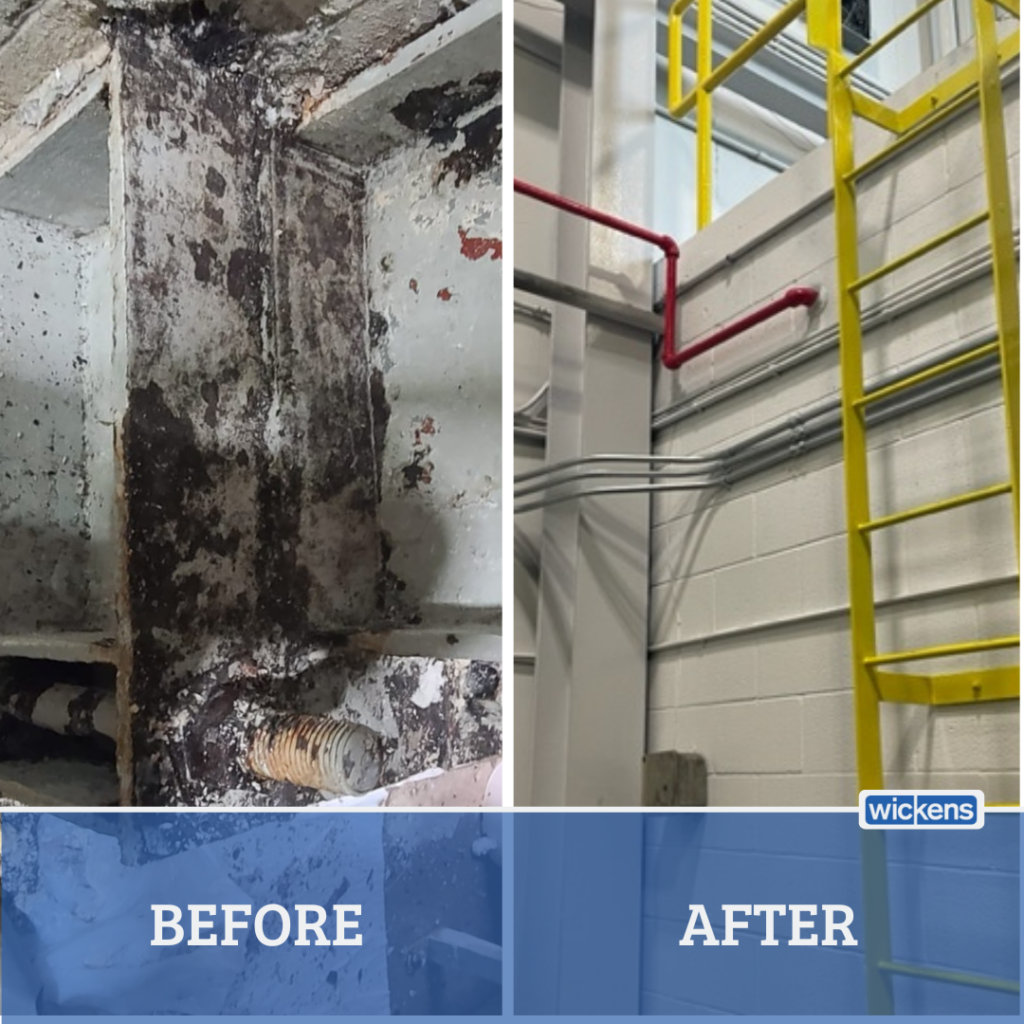Case Study: Industrial Painting and Cleaning of Major Rail Yard Wash Bay
 Techniques Used: Dry Ice Blasting, Encapsulation & Industrial Painting
Techniques Used: Dry Ice Blasting, Encapsulation & Industrial Painting
Service: Contract Cleaning & Industrial Painting
When performing an industrial painting job, it’s critical to prepare surfaces to ensure proper adhesion of the coating, and to ensure the job will look good for years. In many industrial buildings, the chemicals used on-site can affect the building’s surfaces, which means your team needs to know how to clean the surfaces effectively.
At Wickens, we work on complicated projects that require unique solutions. Explore our latest case study, in which we created unique cleaning solutions to prepare a major rail yard wash bay for painting.
The Situation
Our client called the Wickens team to complete contract cleaning and industrial painting for a rail yard wash bay. The large building, over 150 feet long with 30-foot ceilings, had been used as a wash bay to clean trains for several years. The walls and columns of the building had been affected by diesel fuel and acid splashing up while washing train cars.
Our team was fully prepared to take on this project, but upon arrival, we learned that the damage from the acids had caused heavy corrosion to the building. The diesel fuel had also coated most of the building in a thin layer, which couldn’t be blasted with regular techniques. We knew we had to find a solution to these problems quickly to ensure the project stayed on track and so we could clean and paint the wash bay safely.
 The Solution
The Solution
To accommodate the building’s height and size, we worked with our partners to build scaffolding for our team.
As we started the project, we reviewed the steel throughout the building and found extreme levels of corrosion. Blasting alone would not effectively clean the building; instead, more damage would impact the steel, deteriorating it further. This meant that we had to change our strategy to clean the building.
We planned to blast the steel as clean as possible without damage and then use a sealant to encapsulate the building’s surfaces, protecting them and providing stability while preparing them for painting.
We hired an independent consultant to review the structure and our strategy to confirm this was the correct decision. He agreed with our recommendations and thoroughly reviewed the building to provide our clients with the supporting information they needed to agree with our plan.
With the client’s confirmation and approval, we dove into the cleaning and encapsulation process. We blasted surfaces as clean as possible, carefully using gentle abrasion to avoid damaging the steel. Once cleaned, we used Amerlock® sealant across the building to encapsulate the surfaces and protect them from further corrosion. After encapsulation throughout the building, we primed and painted all the surfaces.
This project required two teams of twelve, with both a day and afternoon shift, to adequately meet the three-month deadline.
 The Results
The Results
Once completed, the client was pleased with Wickens’ resolutions and performance on site. While there were changes due to the impact of the contaminants, we quickly jumped in to alleviate their concerns and create an effective solution.
We hired a third-party consultant to review our strategy to alleviate the issues that arose on this project. We and the consultant communicated with the client regularly to update them on our step-by-step process and ensure they were aware of everything happening. This level of communication helped the client feel at ease and comfortable with the process.
Overall, they were pleased with our communications, the completion of the project, and the high-quality painting that was performed. We look forward to working together on future projects.
Wickens Dry Ice Blasting tackles the toughest jobs across Ontario, offering fire restoration, mould remediation, industrial cleaning, asbestos abatement, lead paint abatement, and more. Contact us today for a consultation or emergency service.
- Why You Need an Air Preparation Unit for Dry Ice Blasting - May 13, 2024
- Happy Holidays from Wickens - December 20, 2023
- Maximize Your Year-End Shutdown: The Ideal Time for Industrial Cleaning with Dry Ice Blasting - November 24, 2023

 The Solution
The Solution The Results
The Results